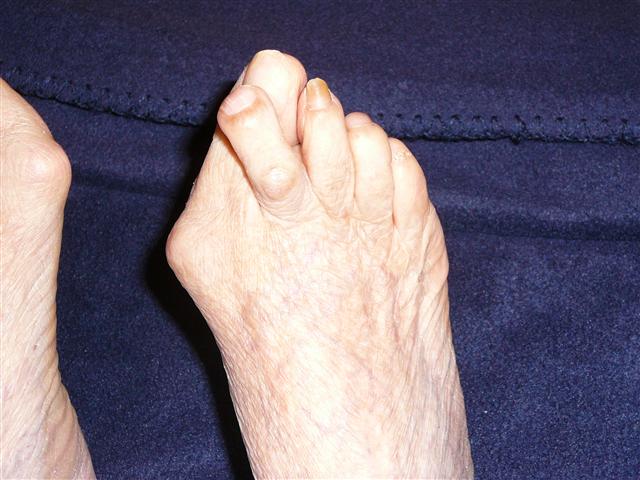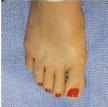A bunion is a structural deformity of the bones and the joint between the foot and big toe, and it may be painful.A bunion is an enlargement of bone or tissue around the joint at the base of the big toe (metatarsophalangeal joint).The big toe may turn in toward the second toe (angulation), and the tissues surrounding the joint may be swollen and tender.

Today the term usually is used to refer to the pathological bump on the side of the great toe joint. The bump is the swollen bursal sac and/or an osseous (bony) deformity that has grown on the mesophalangeal joint (where the first metatarsal bone and hallux meet).
The term “hallux valgus” or “hallux abducto valgus” are the most commonly-used medical terms associated with a bunion deformity, where “hallux” refers to the great toe, “valgus” refers to the abnormal angulation of the great toe commonly associated with bunion deformities, and “abducto” refers to the abnormal drifting or inward leaning of the great toe towards the second toe, which is also commonly associated with bunion disorders.
Bunions are caused by a biomechanical abnormality, where certain tendons, ligaments, and supportive structures of the first metatarsal are no longer functioning correctly. This biomechanical abnormality may be caused by a variety of conditions intrinsic to the structure of the foot–such as flat feet, excessive ligamentous flexibility, abnormal bone structure, and certain neurological conditions. These factors are often considered genetic. Although some experts are convinced that poor fitting footwear is the main cause of bunion formation,other sources concede only that footwear exacerbates the problem caused by the original genetic deformity.
Bunions are commonly associated with a deviated position of the big toe toward the second toe, and the deviation in the angle between the first and second metatarsal bones of the foot. The small sesamoid bones found beneath the first metatarsal (which help the flexor tendon bend the big toe downwards) may also become deviated over time as the first metatarsal bone drifts away from its normal position. Arthritis of the great toe joint, diminished and/or altered range of motion, and discomfort with pressure applied to the bump or with motion of the joint, may all accompany bunion development.
Bunions may be treated conservatively with changes in shoe gear, different orthotics

(accommodative padding and shielding), rest, ice, and medications. These sorts of treatments address symptoms more than they correct the actual deformity. Surgery, by a podiatrist may be necessary if discomfort is severe enough or when correction of the deformity is desired.
Procedures are designed and chosen to correct a variety of pathologies that may be associated with the bunion. For instance, procedures may address some combination of:
- removing the abnormal bony enlargement of the first metatarsal,
- realigning the first metatarsal bone relative to the adjacent metatarsal bone,
- straightening the great toe relative to the first metatarsal and adjacent toes,
- realigning the cartilagenous surfaces of the great toe joint,
- addressing arthritic changes associated with the great toe joint,
- repositioning the sesamoid bones beneath the first metatarsal bone,
- shortening, lengthening, raising, or lowering the first metatarsal bone, and
- correcting any abnormal bowing or misalignment within the great toe.
The age, health, lifestyle, and activity level of the patient may also play a role in the choice of procedure.
Bunion Surgery can be performed under local, spinal, or general anesthetic. The trend has moved strongly toward using the less invasive local anesthesia over the years.
Why do bunions come back?
In a study, surgeons from Japan have discovered that the position of the sesamoid bones is an important part of the problem. The sesamoids are two tiny, pea-sized bones that sit just under the main joint of the big toe. They are embedded in the soft tissues and play an important role in how the foot and big toe work. If the sesamoid bones are not properly realigned after bunion surgery (called a bunionectomy), the deformity we call bunion is more likely to come back. It’s possible that these bones shifted after surgery, pulling the muscles, tendons, ligaments, and bones back out of place. If these bones aren’t lined up exactly where they belong, the correction might not hold. Surgeons from Japan showed how this happens in a study of women with known hallux valgus compared with a similar group who did not have this deformity. When it was all said and done, they suggested closer attention by the surgeon to the position of the sesamoid bones. They must be put back in their proper place under the big toe to recreate normal foot biomechanics and avoid recurrence.

Before

After
For more on Bunion Surgery click here
